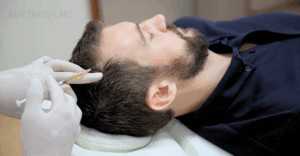There was a time when the only option for cough, balding men, cough, to style their hair was to embrace the dad-ring around the parameter, pick up an electric razor and go commando, toupée shop for a little extra coverage or shell out for 1970s-style plugs. Fast-forward a few decades and male pattern baldness continue to be a real thing, but with much better options.
And it’s warranted too. Approximately two-thirds of all men experience male pattern baldness with the American Hair Loss Association confirming that the thinning begins at the age of 35 years. Think Prince William, Matthew McConaughey, Jude Law and, of course, Jason Alexander. The latest upgrades to hair transplants, however, provide a more realistic looking and feeling alternative.
What is a hair transplant?
Traditionally, a hair transplant is a surgical procedure where the doctor takes healthy, growing hair from the back of your head, beard or another area of your body and inserts it into your balding spot, typically at the crown of your head. “The hair can be harvested by taking a strip out of the back of the head via a Follicular Init Transplant or with a small punch Follicular Unit Extraction,” explains Dr. Robert Jones, BSc, MD, ABHRS, CCFP, FISHRS, of the Toronto Hair Transplant Surgeons. “It is typically done on patients with Male Pattern Baldness.”
How has hair transplant technology advanced?
If you think back to the ‘70s and ‘80s when hair plugs were having a moment, anyone and everyone who had the procedure done could pretend they didn’t, but the tiny sprouts in perfect growth formation always gave them away. “Now with modern hair transplants, we can do this procedure with no sign on the donor or recipient area!” says Dr. Jones. “There’s no scarring and it’s completely natural looking. The hairs are moved one at a time.”
Should you do it?
If you’re feeling slightly less than confident about how much scalp you’re showing and shaving it all off is not your thing, then definitely. Especially if you have “a good thick donor area and a large recipient area to cover,” says Dr. Jones. In other words, your hairy back of the head and chest can easily accommodate your bald patch.
Procedure facts:
Depending on the size of your bald patch and how much coverage you want will dictate the length of the procedure. That said, it will all be done under a local anaesthetic and you’ll be able to drive yourself home or to the office afterwards. “Hair transplants have come a long way in the past five to 10 years,” says Dr. Jones. “In the right experienced hands, having a full head of hair is an option for everyone. With an early start, we can prevent further hair loss and restore a full head of hair in almost every patient.” Just make sure that the doctor you see is Board Certified and restricts his practice to hair restoration, because when it’s all done, “even your barber won’t know you have had the procedure,” says Dr. Jones.
Down-time and cost?
The procedure will take approximately one week to ten days to fully heal and prices range from $5000 to $15,000.





